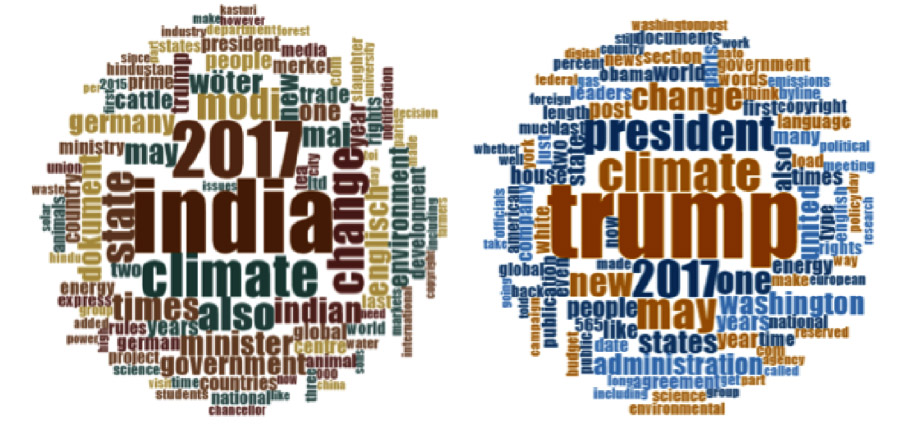Monthly Summaries
Issue 5, May 2017
[DOI]
May 2017 coverage of climate change and global warming increased compared to the previous month, as overall coverage across all sources in twenty-eight countries showed an approximate 10 percent increase compared to April 2017. Coverage of political, scientific, ecological/meteorological, and cultural dimensions of climate change increased most prominently in Africa and Asia, which saw 31 percent and 28 percent increases in coverage, respectively. Europe and North American also saw modest month-to-month increases in coverage, while the Middle East, Oceania, and South America all showed slight decreases compared to the previous month. Europe (142%), Oceania (81%), and Asia (22%) all increased coverage of climate change compared to May 2016. Overall, coverage across all sources in twenty-eight countries decreased approximately 43 percent compared to May 2016.

Word frequency in climate change and global warming coverage in May 2017 from four Indian newspapers (left) and five US newspapers (right). For India: The Indian Express, The Hindu, the Hindustan Times, and The Times of India. For US: The Washington Post, The Wall Street Journal, The New York Times, USA Today, and the Los Angeles Times.
With an overall increase in coverage, political themes in May 2017 continued to focus on the United States’ involvement with the Paris Climate Agreement. The Hindustan Times reported on the uncertainty surrounding the Trump Administration’s decision on whether or not to withdraw from the Agreement and cited the Group of Seven (G7) meeting in Italy as a key date in the overall decision process. Another article in the Manila Bulletin considered the impacts of a U.S withdrawal from the Agreement and described the mounting pressure on the Trump Administration from international leaders to stay the course. Other political coverage focused on the response of international leaders to a U.S. abdication. Indrani Bagchi of The Times of India reported on a renewed partnership between Germany and India, which has helped to reaffirm each countries’ commitment to emissions reductions under the Paris Agreement in the face of a U.S. withdrawal.
Coverage of scientific and ecological dimensions of climate change in May 2017 centered on a number of new reports on carbon emissions. Henry Fountain at The New York Times summarized a recent academic study that details drastic changes to the carbon cycle in Arctic and near-Arctic regions as a result of a warming climate. The new study suggests that due to warming temperatures, these regions are shifting away from a net sink or “storehouse” of carbon to a net source of carbon emissions. Chelsea Harvey at The Washington Post also drew from new analyses by the Climate Action Tracker on the progress China and India have made in meeting their emissions reductions goals under the Paris Climate Agreement. Overall, the two countries are on track to exceed their climate pledges while the current trajectory U.S. emissions reductions lags behind.
The Trump Administration and the Paris Climate Agreement also consumed cultural coverage of climate change in May 2017, continuing an ongoing trend. Alexandra Zavis of the The Los Angeles Times wrote about President Trump’s visit with Pope Francis, who provided the President with a copy of his 2015 encyclical that called for global collective action to address climate change. Another article, this time in the Des Moines Register, summarizes a recent report on activists and law enforcement officials focused on the Dakota Access Pipeline. The report describes how an international security firm targeted protesters opposed to the Dakota Access Pipeline with military-style counter-terrorism measures and closely collaborated with law enforcement authorities in five U.S. states.
